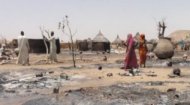Lake Chad FactsTags: Lake Chad, Lake Chad Facts, Lake Chad Shrinking, Lake Chad Crisis, Lake Chad Video, Lake Chad Map |
|
Lake Chad |
Lake Chad |
Lake Chad | Lake Chad |
|
|
The lake is home to numerous fish species, including Tilapia and Catfish, sustaining a vibrant fishing industry. It is also a vital stopover point for millions of migratory birds along the African-Eurasian flyway, making it a globally important wetland. The surrounding vegetation, including papyrus swamps and acacia woodlands, supports various wildlife. For the estimated 30 million people living within its basin, Lake Chad is more than just a body of water; it is an economic and cultural cornerstone. Millions depend directly on the lake for their livelihoods, engaging in fishing, farming along its receding shores, and pastoralism, grazing livestock on its fertile floodplains. The water is used for irrigation, domestic consumption, and supports local markets and trade networks, fostering interconnected communities across the four riparian countries. The lake's continued existence is intrinsically linked to the food security, economic stability, and social cohesion of the region. The dramatic decline of Lake Chad is attributed to a complex interplay of factors, creating a "perfect storm" of environmental and socio-economic challenges:
The shrinking of Lake Chad has profound and far-reaching consequences. The loss of livelihoods has pushed millions into poverty and food insecurity, leading to mass displacement and migration within and out of the basin. Competition over diminishing resources, particularly arable land and water, fuels inter-communal tensions and conflicts. The environmental degradation contributes to desertification, further reducing productive land and exacerbating the humanitarian crisis. The sheer scale of the crisis in the Lake Chad basin has been recognised as one of the world's most severe humanitarian emergencies by the United Nations. Addressing the multifaceted crisis of Lake Chad requires a concerted, multi-pronged approach involving local communities, national governments, and international partners. The Lake Chad Basin Commission (LCBC), established in 1964 by the riparian states, plays a crucial role in coordinating efforts for sustainable management of the lake's resources. Its mandate includes ensuring rational management, preventing conflicts, and promoting regional integration. Current efforts focus on:
More ambitious proposals, such as the Transaqua project, which envisions diverting water from the Congo River basin to replenish Lake Chad, have been debated. While offering a potential long-term solution to water scarcity, such mega-projects face significant environmental, engineering, financial, and political hurdles. For now, the focus remains on localised, sustainable interventions and strengthening the capacity of the LCBC. Lake Chad stands as a stark reminder of the interconnectedness of climate, environment, and human well-being. Its future hangs in the balance, dependent on effective regional cooperation, sustainable resource management, and concerted efforts to address both the environmental degradation and the underlying socio-political challenges that plague this vital African artery. |








